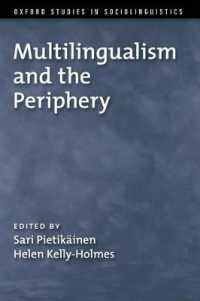Full Description
Articulates the relationships between kinship, racial ideology, mixed blood treaty provisions, and landscape transformation in the Great Lakes region.
In the Great Lakes region of the nineteenth century, "mixed bloods" were a class of people living within changing indigenous communities. As such, they were considered in treaties signed between the tribal nations and the federal government. Larry Nesper focuses on the implementation and long-term effects of the mixed-blood provision of the 1854 treaty with the Chippewa of Wisconsin. That treaty not only ceded lands and created the Ojibwe Indian reservations in the region, it also entitled hundreds of "mixed-bloods belonging to the Chippewas of Lake Superior," as they appear in this treaty, to locate parcels of land in the ceded territories. However, quickly dispossessed of their entitlement, the treaty provision effectively capitalized the first mining companies in Wisconsin, initiating the period of non-renewable resource extraction that changed the demography, ecology, and potential future for the region for both natives and non-natives. With the influx of Euro-Americans onto these lands, conflicts over belonging and difference, as well as community leadership, proliferated on these new reservations well into the twentieth century. This book reveals the tensions between emergent racial ideology and the resilience of kinship that shaped the historical trajectory of regional tribal society to the present.
Contents
List of Illustrations
Acknowledgments
Foreword
Introduction
1. Ojibwe Ethnogenesis and the Fur Trade
2. Descent Ideology, Sociality, and the Transformation of Indigenous Society
3. Ojibwe Treaties, the Emerging Paradigm of Race, and Allotting Mixed Bloods
4. "Mixed Bloods" in the Southwest Sector of Anishinaabewaki
5. Implementing the Mixed-Blood Provision of the 1854 Treaty of La Pointe
6. Constituting Reservation Society on the Emerging Postdispossession Landscape
7. Allotment and the Problems of Belonging
Conclusion
Epilogue
Notes
Bibliography
Index








